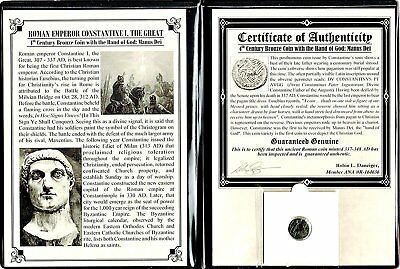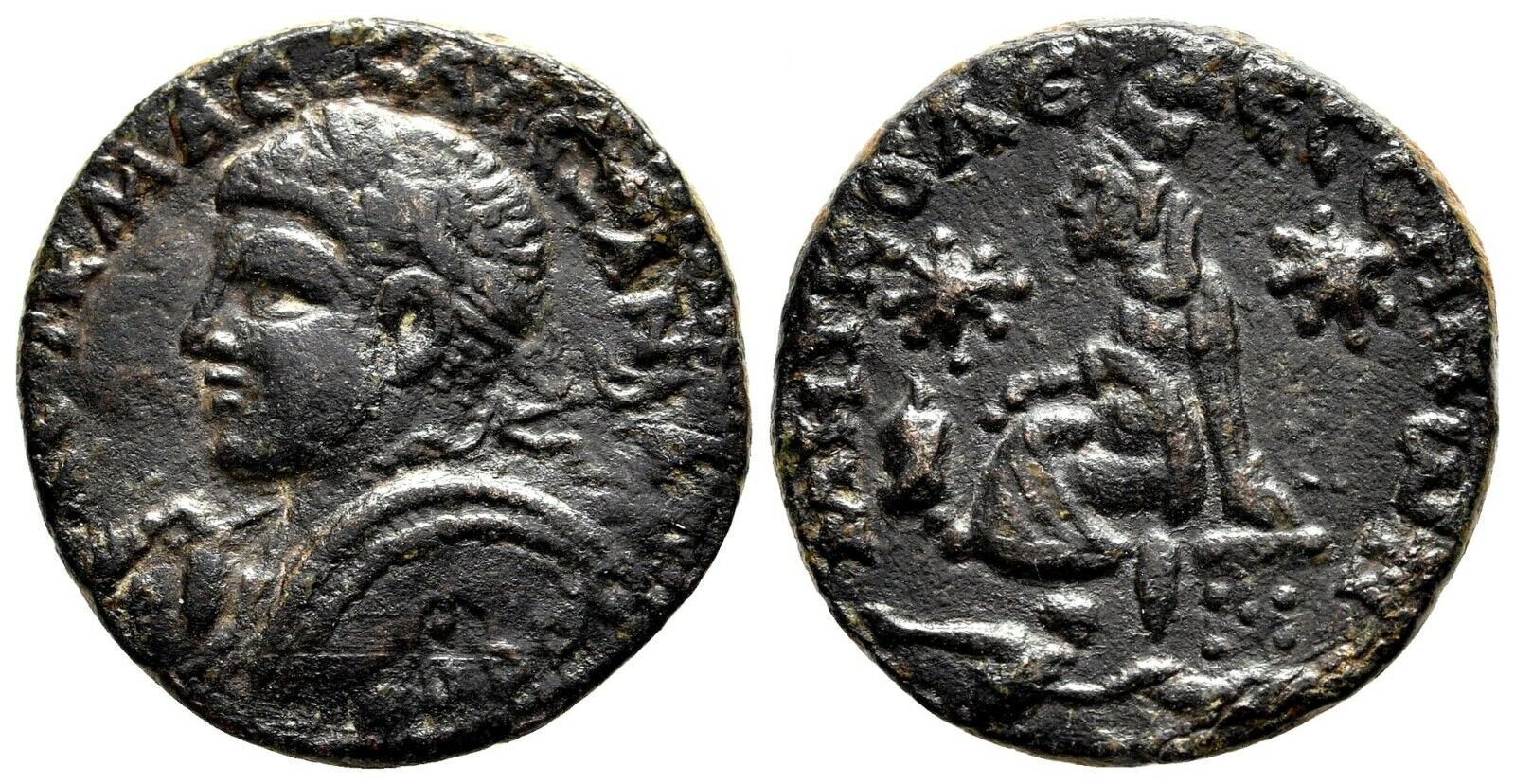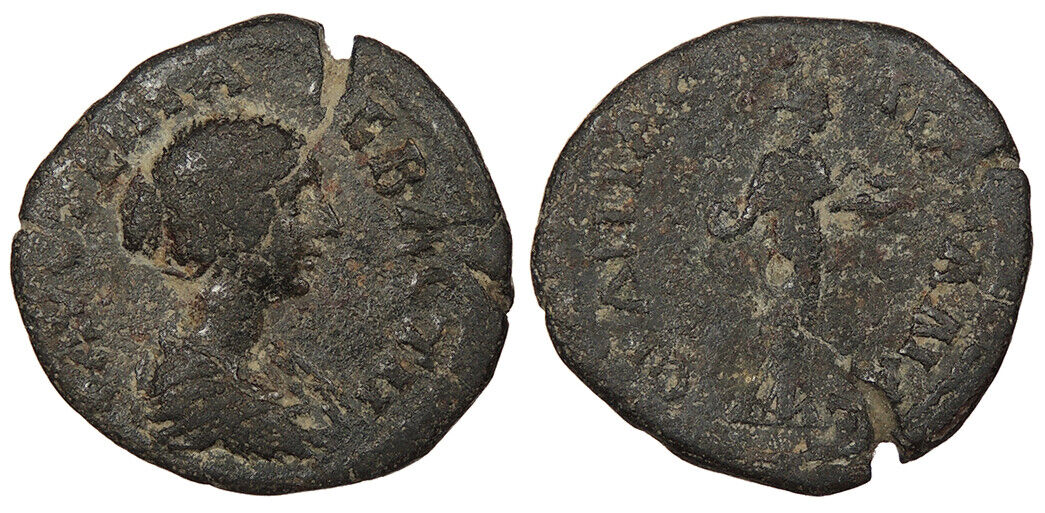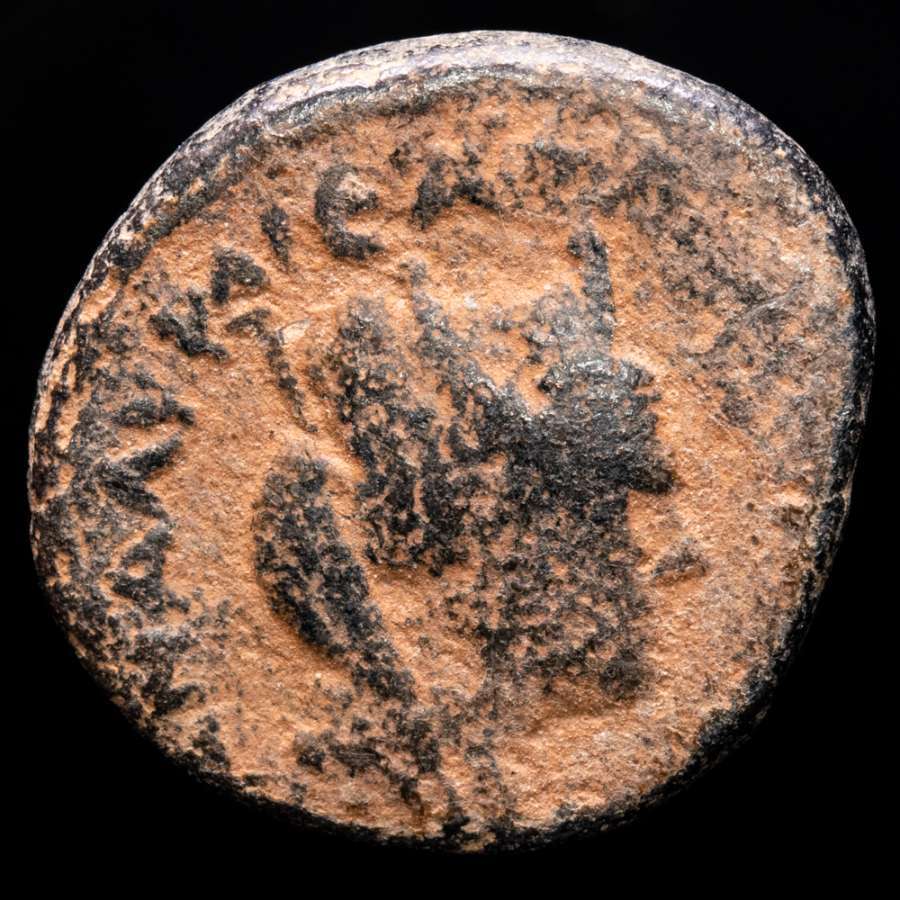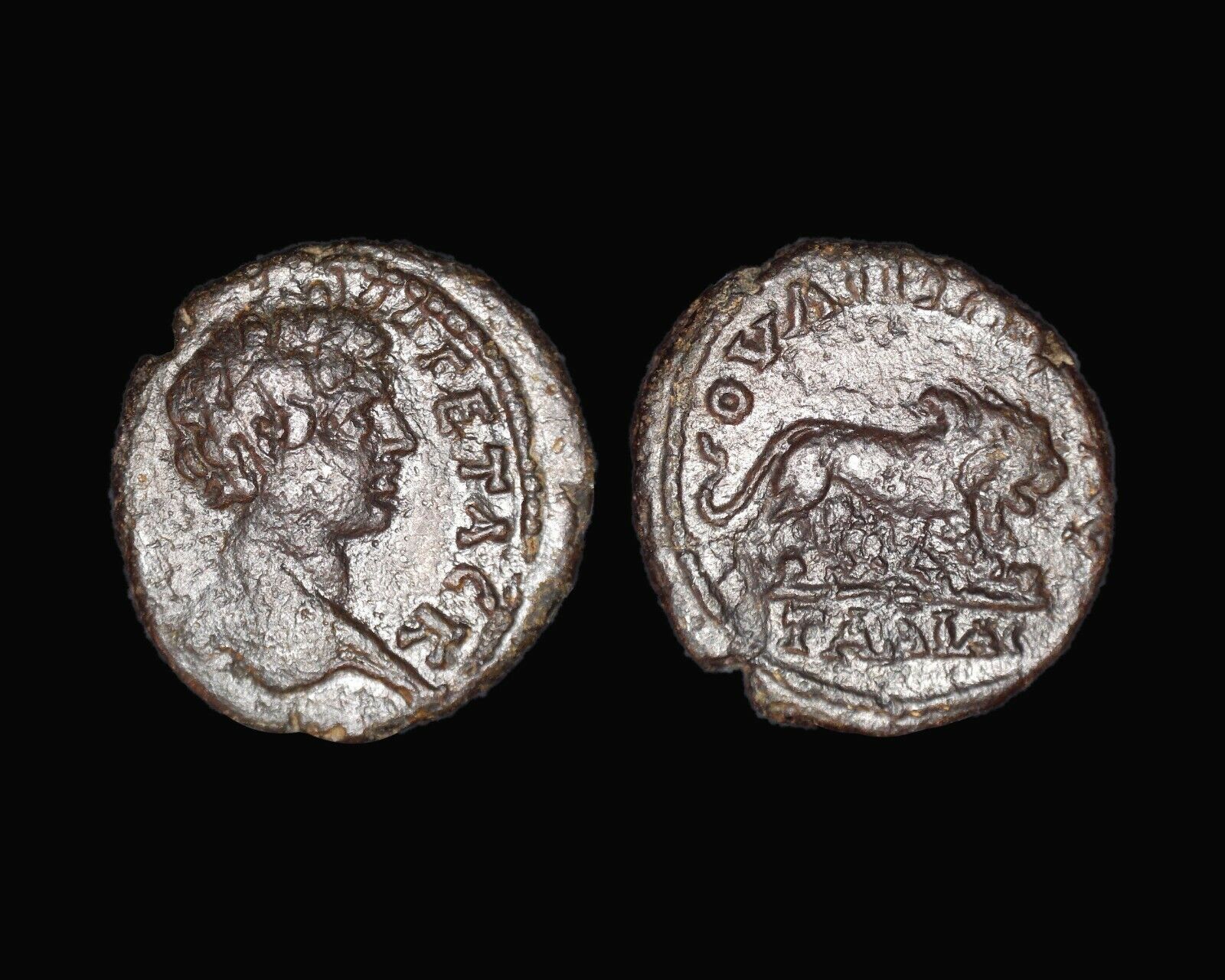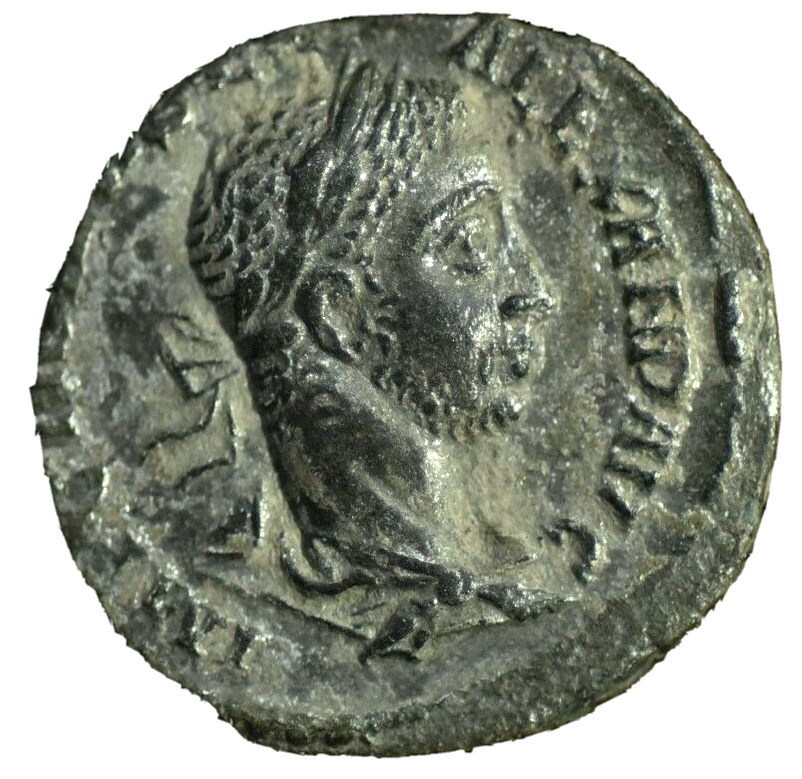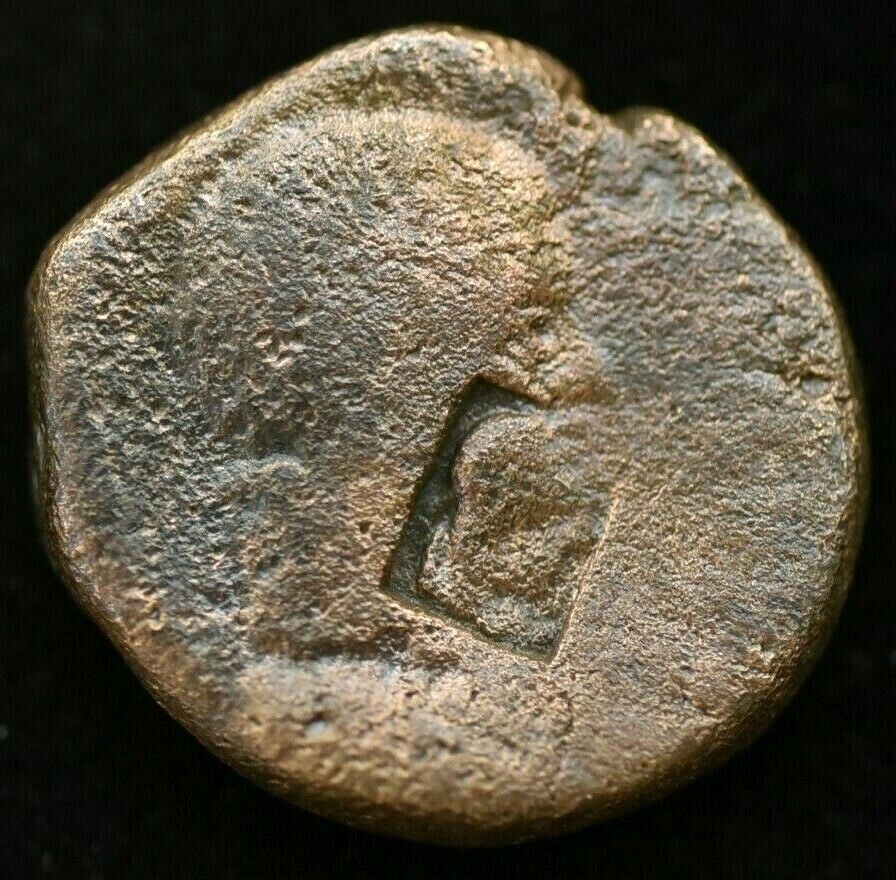-40%
Herennia Ancient Viminacium MOESIA Roman Coin Bull & Lion Legion i33975 RARE
$ 42.24
- Description
- Size Guide
Description
Item:i33975
Authentic Ancient Coin of:
Herennia Etruscilla - Roman Empress wife of Trajan Decius -
Bronze 27mm (10.72 grams) Roman Colony of Viminacium, MOESIA SUPERIOR
Reference: Moushmov 48, SNGCop 164, SGI 4220. --
HER ETRVSCILLA AVG, draped bust right on crescent moon
P M S COL VIM, Moesia standing left between bull & lion, AN XII in ex.
You are bidding on the exact item pictured, provided with a Certificate of Authenticity and Lifetime Guarantee of Authenticity.
Legio septima
Claudia Pia Fidelis
(
Seventh
Claudian
Legion
) was a
Roman legion
. Its emblem, as well as of all Caesar's legions, was the bull, together with the lion.
The 7th, along with the
6th
,
8th
&
9th
were all founded by Pompey in Spain in 65 BC. They were ordered to
Cisalpine Gaul
around 58 BC by
Julius Caesar
, and marched with him throughout the entire Gallic Wars.
Legio VII was one of the two legions used in
Caesar's invasions of Britain
, and played a crucial role in The
Battle of Pharsalus
in 48 BC, and it existed at least until the end of the 4th century, guarding middle
Danube
.
Tiberius Claudius Maximus
the Roman soldier who brought the head of
Decebalus
to emperor
Trajan
was serving in Legio VII Claudia.
Map of the Roman empire in AD 125, under emperor
Hadrian
Legio VII Claudia
, stationed on the river
Danube
at
Viminacium
(Kostolac, Serbia), in
Moesia Superior
province, from AD 58 until the 4th century
Annia Cupressenia Herennia Etruscilla
was
Augusta
(Sept. 249 - Jun. 251) of the
Roman Empire
, wife of
Emperor
Decius
, and mother of Emperors
Herennius Etruscus
and
Hostilian
.
As with most third century Roman empresses, very little is known about her. Probably of senatorial family, she became regent on her son Hostilian, when Decius and Herennius were defeated and killed in the
Battle of Abrittus
to sink into obscurity after her husband and sons perished. It is assumed that her ancestors settled in
Etrurian
lands. Herennia married Decius probably before 230 and gained the title
Augusta
. Her sons were
Herennius Etruscus
and
Hostilian
.
Viminacium
(
VIMINACIVM
) was a major city (provincial capital) and military camp of the
Roman
province of
Moesia
(today's
Serbia
), and the capital of
Moesia Superior
. The site is located 12 km from the modern town of
Kostolac
in Eastern Serbia. The city dates back to the 1st century AD, and at its peak it is believed to have had 40.000 inhabitants, making it one of the biggest cities of that time. It lies on the Roman road
Via Militaris
. Viminacium was devastated by
Huns
in the 5th century, but was later rebuilt by
Justinian
. It was completely destroyed with the
arrival
of
Slavs
in the 6th century. Today, the archeological site occupies a total of 450 hectares, and contains remains of temples, streets, squares, amphitheatres, palaces, hippodromes and Roman baths.
History
A XXV the scene of the
Trajan's Column
, which may have been accounted for "headquarters" of the Roman Emperor: Viminacium.
The remains of Viminacium, the capital of the Roman province of
Moesia Superior
, are located on territories of the villages of Stari Kostolac and Drmno, about 12 km from the town of
Kostolac
and about 90 miles southeast of
Belgrade
. Viminacium was one of the most important Roman cities and military camps in the period from 1st to 4th centuries. Its exceptional strategic importance was reflected both in the defense of the northern border of the Roman empire and in turn of communications and commercial transactions. No less appealing to the Romans was the hinterland of the
Mlava
river valley, which is rich in ore and grains. In Roman times, the town on the northern side of relying directly on the branch of the
Danube
, while the western side, touching the walls Mlava rivers. Only in the later period, Viminacium spread to the left bank of Mlava. Thanks to the location, land and waterways, Viminacium represented one of those areas where the encounter of cultures between East and West was inevitable. Although these roads were the primary military and strategic function, they are taking place throughout antiquity very lively traffic and certainly contributed to the very Viminacium become prosperous and an important trading and business headquarters. In Viminacium,
Roman legion VII Claudia
was stationed, and a nearby civilian settlement emerged from the military camp. In 117 during the reign of
Hadrian
it received city status. In the camp, 6.000 soldiers were stationed, and 30-40.000 lived nearby. In the first half of the 3rd century the city was in full development, as evidenced by the fact that at that time it acquired the status of a Roman colony, and the right to coin local money. Here, in 211,
Septimius Severus
was proclaimed emperor by his son
Caracalla
. In the mausoleum and the excavated tombs, the Roman emperor
Hostilian
, who died in 251, was buried.
A legion may have been stationed here as early as Augustus (27 BC-14 AD). In 33/34 AD a road was built, linking Viminacium and
Ratiaria
.
Claudius
(41-54) garrisoned Viminacium,
Oescus
and
Novae
as camps for the Moesian legions.
The first legion attested at Viminacium was the VII Claudia that came from Dalmatia in 52 AD .
Emperor Trajan
(98-117) was headquartered here during the
Dacian Wars
. It became a
colonia
with minting privilege in 239 AD during the rule of
Gordian III
(238-244) and housed the Legion VII and Legion IV.
Emperor
Hostilian
was the son of the emperor
Decius
, who was killed in the ambush near the ancient city of Abrutus located in present day Bulgaria. According to the old manuscript, emperor Hostilian and his mother came to Viminacium to supervise the organization of defense of northern borders, but both of them died of the plague. Because of the distance and the fear of spreading the plague, he was buried with all honors in Viminacium
Viminacium was the provincial capital of
Moesia Superior
. In the late spring of 293-294,
Diocletian
journeyed through his realm and he re-organized Viminacium as the capital of the new province of
Moesia Superior Margensis
. He registered that the people wrote in Latin, as opposed to Greek in the southern provinces. Viminacium was the base camp of
Claudia
Legio VII
, and hosted for some time the
Flavia Felix
IIII
. It had a Roman amphitheatre with room for 12,000 people.
In 382 the city was the meeting place between
Theodosius
and
Gratian
amidst the
Gothic Wars
.
Viminacium was destroyed in 441 by the
Attila the Hun
, but rebuilt by
Justinian I
. During
Maurice's Balkan campaigns
, Viminacium saw destruction by the
Avars
in 582 and a
crushing defeat
of Avar forces on the northern Danube bank in 599, destroying Avar reputation for invincibility.
[3]
Location and excavation
Valerian
AD 253-260. AR Antoninianus. Viminacium mint. 1st emission, 1st phase, AD 253.
Viminacium is located in
Stari Kostolac
(Old
Kostolac
) a
Serbian
town on the
Danube
river, east of
Belgrade
. Viminacium is the location of the first archaeological excavation in Serbia, which started in 1882, by
Mihailo Valtrović
, an architect by profession and the first professor of archeology at the college in
Belgrade
. The only help he received was from 12 prisoners, because the state did not have enough resources to provide him with a better work force. His research was continued by
Miloje Vasić
, in the 1970s
[
clarification needed
]
. It has intensified in the last ten years in the area of the Roman city of the Roman legionary camps and cemeteries. Many studies suggest that the military camp at Viminacium had a rectangular plan, measuring 442 x 385 meters, and that is not far from its western wall of civilian settlement in an area of approximately 72 acres. Legionary camp in Viminacium is now in a layer of arable land, so that wealth Viminacium easily accessible to researchers, but, unfortunately, and the robbers.The National Museum in
Belgrade
and
Požarevac
kept some 40,000 items found in Viminacium, of which over 700 made of gold and silver. Among them are many objects that represent the European and world rarities invaluable.
It has been discovered and more than 13,500 graves. Tombstones and sarcophagi are often decorated with relief representations of scenes from mythology or daily life. We have found numerous grave masonry construction. Especially interesting are the frescoes of the 4th-century tombs.
Fresco
with the notion of young women in artistic value of the extreme range of late antique art. During the excavation, an amphitheater, which with its 12,000 seats was one of the largest in the
Balkans
.
Frequently Asked Questions
How long until my order is shipped?
Depending on the volume of sales, it may take up to 5 business days for shipment of your order after the receipt of payment.
How will I know when the order was shipped?
After your order has shipped, you will be left positive feedback, and that date should be used as a basis of estimating an arrival date.
After you shipped the order, how long will the mail take?
USPS First Class mail takes about 3-5 business days to arrive in the U.S., international shipping times cannot be estimated as they vary from country to country. I am not responsible for any USPS delivery delays, especially for an international package.
What is a certificate of authenticity and what guarantees do you give that the item is authentic?
Each of the items sold here, is provided with a Certificate of Authenticity, and a Lifetime Guarantee of Authenticity, issued by a world-renowned numismatic and antique expert that has identified over 10000 ancient coins and has provided them with the same guarantee. You will be quite happy with what you get with the COA; a professional presentation of the coin, with all of the relevant information and a picture of the coin you saw in the listing.
Compared to other certification companies, the certificate of authenticity is a -50 value. So buy a coin today and own a piece of history, guaranteed.
Is there a money back guarantee?
I offer a 30 day unconditional money back guarantee. I stand behind my coins and would be willing to exchange your order for either store credit towards other coins, or refund, minus shipping expenses, within 30 days from the receipt of your order. My goal is to have the returning customers for a lifetime, and I am so sure in my coins, their authenticity, numismatic value and beauty, I can offer such a guarantee.
Is there a number I can call you with questions about my order?
You can contact me directly via ask seller a question and request my telephone number, or go to my About Me Page to get my contact information only in regards to items purchased on eBay.
When should I leave feedback?
Once you receive your order, please leave a positive. Please don't leave any negative feedbacks, as it happens many times that people rush to leave feedback before letting sufficient time for the order to arrive. Also, if you sent an email, make sure to check for my reply in your messages before claiming that you didn't receive a response. The matter of fact is that any issues can be resolved, as reputation is most important to me. My goal is to provide superior products and quality of service.



